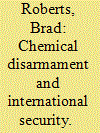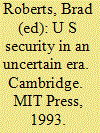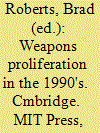|
|
|
Sort Order |
|
|
|
Items / Page
|
|
|
|
|
|
|
| Srl | Item |
| 1 |
ID:
002805


|
|
|
|
|
| Publication |
London, Brassey's, 1992.
|
| Description |
84p.
|
| Series |
IISS. International Institute for Strategic Studies, Adelphi Paper;267
|
| Standard Number |
1857530179
|
|
|
|
|
|
|
|
|
|
|
|
Copies: C:1/I:0,R:0,Q:0
Circulation
| Accession# | Call# | Current Location | Status | Policy | Location |
| 034313 | R 355.03/ROB 034313 | Main | On Shelf | General | |
|
|
|
|
| 2 |
ID:
165751


|
|
|
|
|
| Summary/Abstract |
US adoption of no-first-use would undermine deterrence at a time when it is already weakening.
|
|
|
|
|
|
|
|
|
|
|
|
|
|
|
|
| 3 |
ID:
006399


|
|
|
|
|
| Publication |
Cambridge, MIT Press, 1996.
|
| Description |
xvii, 437p.
|
| Standard Number |
0262680890
|
|
|
|
|
|
|
|
|
|
|
|
Copies: C:1/I:0,R:0,Q:0
Circulation
| Accession# | Call# | Current Location | Status | Policy | Location |
| 038096 | 337/ROB 038096 | Main | On Shelf | General | |
|
|
|
|
| 4 |
ID:
172895


|
|
|
|
|
| Summary/Abstract |
Since the end of the Cold War, changes to the practice of nuclear deterrence by the United States have been pursued as part of a comprehensive approach aimed at reducing nuclear risks. These changes have included steps to reduce reliance on nuclear weapons in U.S. defense and deterrence strategies. Looking to the future, the United States can do more, but only if the conditions are right. Policy-makers must avoid steps that have superficial appeal but would actually result in a net increase in nuclear risk. These include steps that make U.S. nuclear deterrence unreliable for the problems for which it remains relevant.
|
|
|
|
|
|
|
|
|
|
|
|
|
|
|
|
| 5 |
ID:
165272


|
|
|
| 6 |
ID:
169174


|
|
|
| 7 |
ID:
179183


|
|
|
|
|
| Summary/Abstract |
With its March 2021 Interim National Security Strategic Guidance, the Biden administration set down its first markers on nuclear policy. On international nuclear diplomacy, it committed to “head off costly arms races and re-establish our credibility as a leader in arms control,” “pursue new arms control arrangements” “where possible,” “engage in meaningful dialogue with Russia and China on a range of emerging military technological developments that implicate strategic stability,” and “renew” US leadership of international nonproliferation diplomacy. This was in the context of a commitment “to elevate diplomacy as our tool of first resort.”1 On deterrence strategy, the administration committed to “reduce the role of nuclear weapons in our national security strategy, while ensuring our strategic deterrent remains safe, secure, and effective and that our extended deterrence commitments to our allies remain strong and credible.”2 This was in the context of commitments “to reinvigorate and modernize our alliances” and “to make smart and disciplined choices regarding our national defense.
|
|
|
|
|
|
|
|
|
|
|
|
|
|
|
|
| 8 |
ID:
153369


|
|
|
|
|
| Summary/Abstract |
As an organising concept, strategic stability played a central role in the strategic policy of the Obama administration, as set out in its policy and posture reviews of 2009 and 2010. The administration used strategic stability as a guide to policy development in a changed security environment, and valued it particularly in advancing cooperation with Russia and China at what seemed a hopeful moment in relations with both countries. Eight years later, it is time to take stock of the results of that approach, and to look for lessons. As the Trump administration conducts its own reviews, it must assess whether and how strategic stability might fit with its own guiding principles, such as ‘America First’ and ‘peace through strength’.
|
|
|
|
|
|
|
|
|
|
|
|
|
|
|
|
| 9 |
ID:
143683


|
|
|
|
|
| Summary/Abstract |
Tensions on the Korean Peninsula and the security situation of East Asia have been worsening more than ever. Particularly, North Korea’s long-range missile launch on February 7, 2016, and subsequent shutdown of the Kaesong Industrial Complex by the ROK government make the possibility of improving inter-Korean relations even more difficult. North Korea claims that the missile launch was a longrange rocket to put a remote-sensing satellite into orbit, but no country has received any signal transmitted from the satellite. The same was the case in 2012. North Korea has been giving no care to the expectations of the international community and UN sanctions, and continuously developing its nuclear and missile capabilities. Expressing its willingness to use extreme measures, the North raises security concerns not only to the ROK and its ally, the United States, but also to all regional countries. Deployment of THAAD in the ROK and UN sanctions will likely follow. Thus tensions in the region will continue for some time. Both the ROK and the United States are consistently developing tailored deterrence strategy in order to effectively deal with North Korea’s nuclear and missile threat. I would like to introduce a special article that has succinctly put together the background of the issue and key points with authority. I would like to extend my gratitude to Dr. Brad Roberts for agreeing to contribute this valuable article to our journal.
|
|
|
|
|
|
|
|
|
|
|
|
|
|
|
|
| 10 |
ID:
004789


|
|
|
|
|
| Publication |
Cambridge, MIT Press, 1993.
|
| Description |
x,418p.
|
| Contents |
All articles have been published in Washington Quarterly Reader
|
| Standard Number |
026218155X
|
|
|
|
|
|
|
|
|
|
|
|
Copies: C:1/I:0,R:0,Q:0
Circulation
| Accession# | Call# | Current Location | Status | Policy | Location |
| 035779 | R 355.033073/ROB 035779 | Main | On Shelf | General | |
|
|
|
|
| 11 |
ID:
001778


|
|
|
|
|
| Publication |
Hague, Kluwer Law International, 1996.
|
| Description |
x, 398p.
|
| Standard Number |
9041102051
|
|
|
|
|
|
|
|
|
|
|
|
Copies: C:1/I:0,R:0,Q:0
Circulation
| Accession# | Call# | Current Location | Status | Policy | Location |
| 038568 | 355.82/ROB 038568 | Main | On Shelf | General | |
|
|
|
|
| 12 |
ID:
005875


|
|
|
|
|
| Publication |
Cmbridge, MIT Press, 1995.
|
| Description |
ix,473p.
|
| Standard Number |
0262680866
|
|
|
|
|
|
|
|
|
|
|
|
Copies: C:1/I:0,R:0,Q:0
Circulation
| Accession# | Call# | Current Location | Status | Policy | Location |
| 037254 | 355.825119/ROB 037254 | Main | On Shelf | General | |
|
|
|
|
|
|
|
|
|